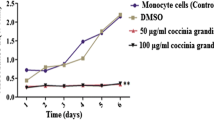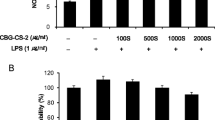Abstract
Lichen species were collected from King George Island (Antarctica) and were screened for their immunomodulatory effect. Among the lichens tested, the methanol extract (CR-ME) of Caloplaca regalis showed the highest nitric oxide (NO) production in murine peritoneal macrophages. Therefore, this study further examined the ability of C. regalis to induce secretory and cellular responses in macrophages. Macrophages were treated with various concentrations of CR-ME for 18 h. The CR-ME treatment induced tumoricidal activity and increased the production of tumor necrosis factor-α (TNF-α) and nitric oxide by macrophages. However, CR-ME had a little effect on the levels of reactive oxygen species, interleukin-1 and IFN-γ in CR-ME-treated macrophages. The CR-ME-induced tumoricidal activity was partially abrogated by a NO inhibitor and the anti-TNF-α antibody. Thus, the tumoricidal effect of CR-ME appeared to be mainly mediated by NO and TNF-α production from macrophages. Treating the macrophages with a p38 mitogen-activated protein kinase (MAPK) inhibitor partially blocked the tumoricidal activation induced by CR-ME, whereas inhibitors of the other kinases did not have an inhibitory effect. These results suggest that CR-ME induces the tumoricidal activity via the p38 MAPK-dependent pathway. Furthermore, electrophoretic mobility shift assay analyses revealed that the CR-ME treatment induced the activation of the NF-κB transcription factor. Overall, these results indicate that the tumoricidal activity induced by CR-ME is mainly due to TNF-α and NO production, and the activation of macrophage by CR-ME is mediated probably via the p38 MAPK and NF-κB pathway. Our results may also provide some leads in the development of new immunomodulating drugs.





Similar content being viewed by others
References
Aga M, Watters JJ, Pfeiffer ZA, Wiepz GJ, Sommer JA, Bertics PJ (2004) Evidence for nucleotide receptor modulation of cross talk between MAP kinase and NF-kappa B signaling pathways in murine RAW 264.7 macrophages. Am J Physiol Cell Physiol 286:C923–930
Ando I, Tsukumo Y, Wakabayashi T, Akashi S, Miyake K, Kataoka T, Nagai K (2002) Safflower polysaccharides activate the transcription factor NF-kappa B via Toll-like receptor 4 and induce cytokine production by macrophages. Int Immunopharmacol 2:1155–1162
Bae SY, Yim JH, Lee HK, Pyo S (2006) Activation of murine peritoneal macrophages by sulfated exopolysaccharide from marine microalga Gyrodinium impudicum (strain KG03): involvement of the NF-kappaB and JNK pathway. Int Immunopharmacol 6:473–484
Chan ED, Riches DW (1998) Potential role of the JNK/SAPK signal transduction pathway in the induction of iNOS by TNF-a. Biochem Biophys Res Commun 253:790–796
Choriki M, Freudenberg M, Calanos C, Poindron P, Bartholeyns J (1989) Antitumoral effects of lipopolysaccharide, tumor necrosis factor, interferon and activated macrophages: synergism and tissue distribution. Anticancer Res 9:1185–1190
Choudhary MI, Azizuddin, Jalil S, Atta-ur-Rahman (2005) Bioactive phenolic compounds from a medicinal lichen, Usnea longissima. Phytochemistry 66:2346–2350
Clark IA (2007) How TNF was recognized as a key mechanism of disease. Cytokine Growth Factor Rev 18:335–343
Decker T, Lohmann-Mathes ML, Gifford G (1987) Cell associated tumor necrosis factor as a killing mechanism of activated cytotoxic macrophages. J Immunol 130:957–962
Ding AH, Nathan CF, Stuer DJ (1988) Release of reactive nitrogen intermediates and reactive oxygen intermediates from mouse peritoneal macrophages. Comparison of activating cytokines and evidence for independent production. J Immunol 141:2407–2412
Dong Z, O’Brian CA, Fidler IJ (1993) Activation of tumoricidal properties in macrophages by lipopolysaccharide requires protein-tyrosine kinase activity. J Leukoc Biol 53:53–60
Fultz MJ, Barber SA, Dieffenbach CW, Vogel SN (1993) Induction of IFN-gamma in macrophages by lipopolysaccharide. Int Immunol 5:1383–1392
Goenka S, Das T, Sa G, Ray PK (1998) Protein A induces NO production: involvement of tyrosine kinase, phospholipase C, and protein kinase C. Biochem Biophys Res Commun 250:425–429
Hahn H, Kaufmann SH (1981) The role of cell-mediated immunity in bacterial infections. Rev Infect Dis 3:1221–1250
Ingolfsdottir K, Jurcic K, Fischer B, Wagner H (1994) Immunologically active polysaccharide from Cetraria islandica. Planta Med 60:527–531
Jaramillo M, Naccache PH, Olivier M (2004) Monosodium urate crystals synergize with IFN-gamma to generate macrophage nitric oxide: involvement of extracellular signal-regulated kinase 1/2 and NF-kappa B. J Immunol 172:5734–5742
Jeon YJ, Han SB, Lee SH, Kim HC, Ahn KS, Kim HM (2001) Activation of mitogen-activated protein kinase pathways by angelan in murine macrophages. Int Immunopharmacol 1:237–245
Keller R, Keist R, Frei K (1990) Lymphokines and bacteria that induce tumoricidal activity, trigger a different secretory response in macrophages. Eur J Immunol 20:695–698
Kim YM, Lee BS, Yi KY, Paik SG (1997) Upstream NF-kappaB site is required for the maximal expression of mouse inducible nitric oxide synthase gene in interferon-gamma plus lipopolysaccharide-induced RAW 264.7 macrophages. Biochem Biophys Res Commun 236:655–660
Lorsbach RB, Murphy WJ, Lowenstein CJ, Snyder SH, Russell SW (1993) Expression of the nitric oxide synthase gene in mouse macrophages activated for tumor cell killing. J Biol Chem 268:1908–1913
Lovett D, Kozan B, Hadam M, Resch K, Gemsa D (1986) Macrophage cytotoxicity: interleukin 1 as a mediator of tumor cytostasis. J Immunol 136:340–347
Lowenstein CJ, Snyder SH (1992) Nitric oxide, a novel biologic messenger. Cell 70:705–707
Martin JH, Edwards SW (1994) Interferon-gamma enhances monocyte cytotoxicity via enhanced reactive oxygen intermediate production. Absence of an effect on macrophage cytotoxicity is due to failure to enhance reactive nitrogen intermediate production. Immunology 81:592–597
Mavier P, Edgington TS (1984) Human monocyte-mediated tumor cytotoxicity. I. Demonstration of an oxygen dependent myeloperoxidase-independent mechanism. J Immunol 132:1980–1984
Müller K (2001) Pharmaceutically relevant metabolites from lichens. Appl Microbiol Biotechnol 56:9–16
Nathan C (1992) Nitric oxide as a secretory product of mammalian cells. FASEB J 6:3051–3564
Oksanen I (2006) Ecological and biotechnological aspects of lichens. Appl Microbiol Biotechnol 73:723–734
Olafsdottir ES, Ingolfsdottir K, Barsett H, Paulsen BS, Jurcic K, Wagner H (1999) Immunologically active (1-3)-(1-4)-alpha-d-glucan from Cetraria islandica. Phytomedicine 6:33–39
Schorey JS, Cooper AM (2003) Macrophage signalling upon mycobacterial infection: the MAP kinases lead the way. Cell Microbiol 5:133–142
Smith RI (1984) Terrestrial plant biology of the sub-Antarctic and Antarctic. In: Laws RM (ed) Antarctic ecology. Academic, London, pp 61–162
Stuehr DJ, Marletta MA (1987) Synthesis of nitrite and nitrate in macrophage cell lines. Cancer Res 47:5590–5594
Um SH, Son EW, Kim BO, Moon EY, Rhee DK, Pyo S (2000) Activation of murine peritoneal macrophages by Streptococcus pneumoniae type II capsular polysaccharide: involvement of CD14-dependent pathway. Scand J Immunol 52:39–45
Verstovsek S, Maccubbin D, Mihich E (1992) Tumoricidal activation of murine resident peritoneal macrophage by interleukin 2 and tumor necrosis factor. Cancer Res 52:3880–3885
Acknowledgment
This work was supported by the Korea Polar Research Institute, grant number PE07050.
Author information
Authors and Affiliations
Corresponding author
Rights and permissions
About this article
Cite this article
Choi, HS., Yim, J.H., Lee, H.K. et al. Immunomodulatory Effects of Polar Lichens on the Function of Macrophages In Vitro. Mar Biotechnol 11, 90–98 (2009). https://doi.org/10.1007/s10126-008-9121-x
Received:
Accepted:
Published:
Issue Date:
DOI: https://doi.org/10.1007/s10126-008-9121-x




